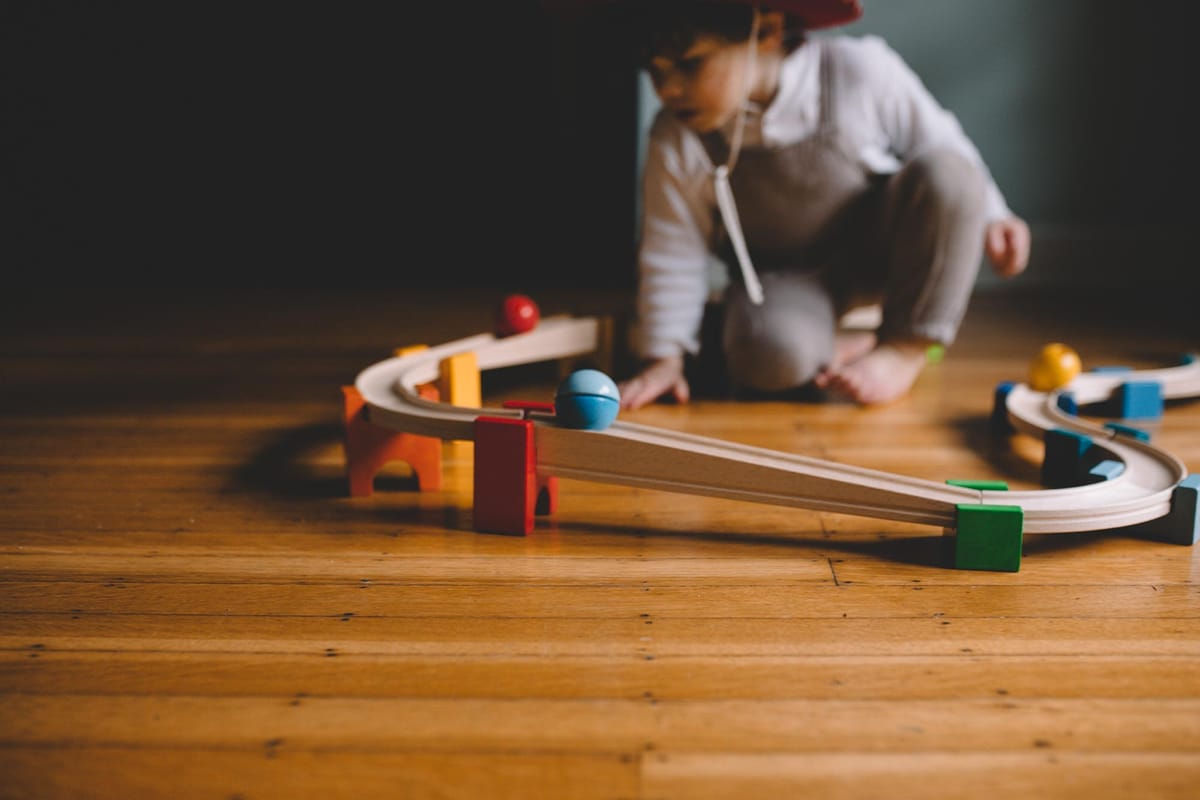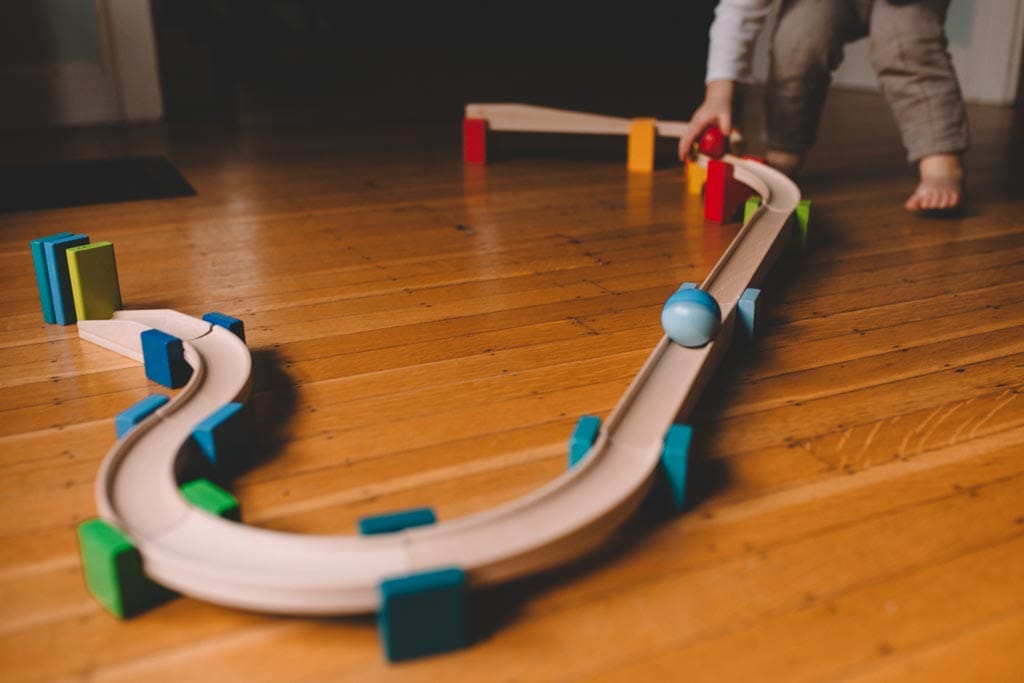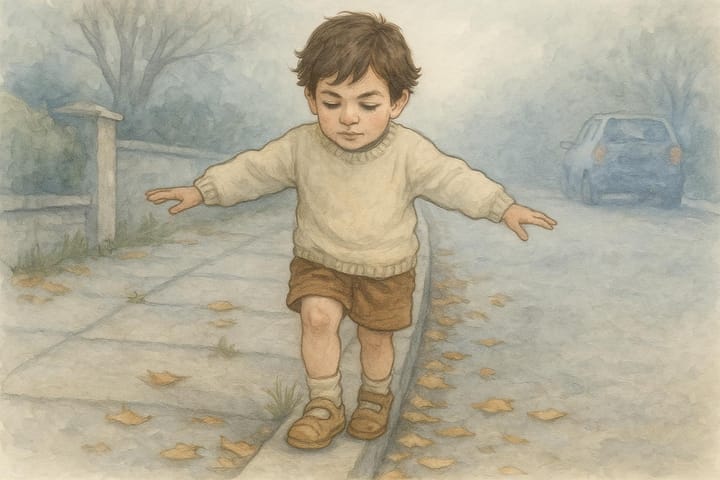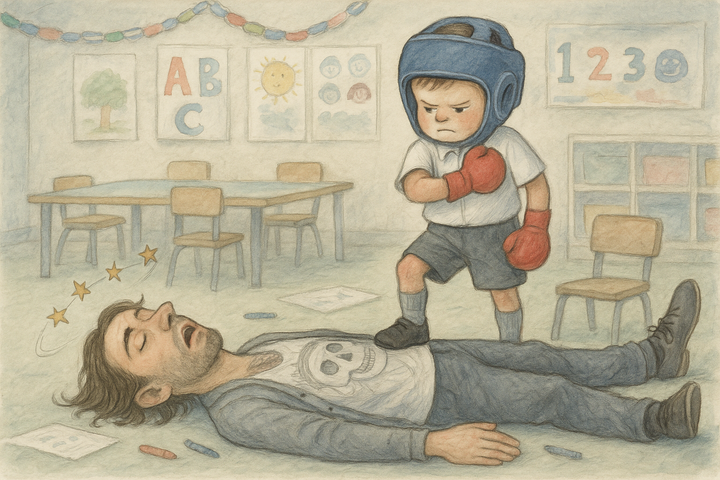Decoding Play
Some kinds of play are special. Your child is engrossed and time stands still. What's the secret? What caused this magical state? And - most importantly - how do you recreate it?

Welcome to Patterns in Play!
If you’re a long-time reader, many of the ideas in today’s email will be familiar to you.
We’re starting with a 30,000 foot overview. In future editions we’ll dive deep into individual schemas and to
But I promise to keep it practical. This newsletter is about finding fun things for your child to explore. We want to offer simple experiences that offer a level of challenge that she can control. The brilliant thing about schema play is that it meets your child where she is. It’s never too easy or too hard. It’s the Goldilocks of play, just right.
This newsletter is all about helping you decode the hidden patterns within your child’s play, known as schemas. Understanding these patterns will give you valuable insights into your child’s learning, helping you support her development naturally and effectively.

What are schemas?
Here is a boy.
He is rolling a ball and he is engrossed in his play.
Down the ball rolls, again and again.

Schemas are repeated patterns of behaviour that help children make sense of the world.
OK, that’s not a very satisfactory definition, even if it’s how you’ll usually seen them described.
Schemas are your child’s best guess at how the world works. Your child has best guesses for all kinds of things, like the way objects roll or how you go from inside to out.
Most importantly, schemas can be - and most often are - wrong.
That’s why they’re repeated so often. They’re patterns in play.
Your child has a hypothesis.
This is how I think things fall. Big things fall faster than little things. I dropped a leaf and it floated down. I dropped a book and it plummeted.
But then your child drops a marble and it plunges to the ground.
Her schema must be updated.
But how? Is there something special about marbles? Is there something about their shape? Do they fall fast because they are round? Or heavy? Or because they are made of glass with a swirly design inside?
There’s only one way to find out: more testing.
And so, over time, her schema becomes more accurate. It stays true in a wider number of situations.
She is learning.
Common schemas
There are an infinite number of schemas but it helps us to think in broad categories. Let’s take a look at the eight most-frequently considered:
- Trajectory Schema. If your child loves throwing, dropping, or rolling objects, she may be exploring trajectory. This schema teaches about movement and direction.
– Example Activity: Set up a ramp using cardboard or books for her to roll cars down, exploring different speeds and angles. - Connecting Schema. This schema is about joining and separating objects, helping children understand relationships and stability.
– Example Activity: Give her Lego blocks or threading beads to assemble and disassemble, encouraging her to test connections. - Transporting Schema. Transporters love to move items from one place to another, whether it’s filling a basket with toys or pushing a walker full of blocks.
– Example Activity: Provide a small bucket or bag and encourage her to transport objects around the room or garden, exploring carrying and gathering. - Enclosing Schema. Children who enjoy surrounding items with blocks or building fences are exploring the enclosing schema, which teaches about boundaries and spatial relationships.
– Example Activity. Use blocks or string to create a “corral” for toys, helping her learn about defining spaces. - Enveloping Schema. This schema is about wrapping and covering objects. Children may hide toys under blankets or bundle things up, exploring concepts of containment and mystery.
– Example Activity: Provide small blankets or scarves for wrapping toys, exploring how items can be hidden or contained. - Rotation Schema. If your child is fascinated by spinning, wheels, or twirling, she’s likely exploring the rotation schema. This builds an understanding of movement and symmetry.
– Example Activity: Offer objects with wheels or tops that she can spin, encouraging her to explore circular movement. - Positioning Schema. Children with a positioning schema love arranging items in order or specific patterns, like lining up toys or creating scenes.
– Example Activity: Give her buttons or blocks to arrange by colour, size, or shape, exploring concepts of order and sequence. - Orientation Schema. If your child loves hanging upside down, lying in unusual positions, or viewing things from odd angles, she may be exploring orientation. This schema is about different perspectives.
– Example Activity: Encourage her to play on the floor or climb to different heights, offering new viewpoints.
OK, so far, so boring. Everyone knows about those schemas.
Progression in schema play – the four levels
Schema play gets interesting when you understand that for each schema, play develops through four levels as your child’s thinking and understanding deepen. These levels, identified by early years researcher Chris Athey, reflect a progression from hands-on exploration to abstract thought, from doing without thinking to thinking without doing. Knowing which level your child is operating at can help you support her play with the right materials and activities, matching her growing capabilities.
Level 1: Motor level – doing without thinking
At this initial stage, your child explores schemas through pure action. She is fully immersed in the sensory experience of touching, moving, and experimenting without consciously planning or reflecting on her actions. For example, she may repeatedly drop objects into a box, shake it to hear the sound, or take items out only to put them back in. There’s no deeper intent yet—she’s simply learning by doing.
Example: A toddler playing with blocks might stack and knock them over repeatedly. She isn’t concerned with creating a structure; instead, she’s exploring the movement and sound of the blocks.
Level 2: Symbolic level – this stands for that
As she begins to understand that objects can represent ideas, your child starts to engage in symbolic play. She might pretend one object is another or act out scenarios. This is the foundation of imaginative play, where a doll becomes a “baby,” or a cardboard box transforms into a “boat.” Symbolic representation allows her to experiment with meaning and narrative, building a bridge between real and pretend.
Example: She might use a spoon to represent a car, driving it across the floor with sound effects. This level of play shows her growing ability to ascribe meaning to objects and actions.
Level 3: Functional dependency level – this depends on that
At this level, your child starts understanding that one action can affect another—a crucial concept known as functional dependency. Here, she is able to recognise simple cause-and-effect relationships, such as knowing that turning a handle changes the length of a hose or adjusting a ramp changes the speed of a car. This thinking is the basis for problem-solving, as she learns that her actions have predictable outcomes.
Example: While playing with a shape sorter, she begins to realise that a shape’s fit depends on how it’s turned. This insight into dependency marks a big step forward in her logical thinking.
Level 4: Thought level – thinking without doing
At the thought level, your child is able to manipulate ideas entirely within her mind. There’s no need to check with physical objects to see if she got it right. Years as a baby and toddler spent exploring objects and their relationships have given her a familiarity which breeds insights and enables her to make predictions without direct action. For example, she can imagine that if it took 10 steps to reach the end of the garden, it will probably take 10 steps to get back. This is the pinnacle of schema play, where thought becomes independent of physical trial.
Example: Your child might plan an entire structure in her mind, knowing that four blocks will create a stable base and visualising the result before starting to build.
Big idea. The progression through these four levels—from movement to thought—reveals how children gradually internalise their experiences. By following her natural instincts, you’re helping her build a strong foundation for future learning.
Start with observation: recognising patterns
How do you know which level your child is operating at - and which schema is most personally significant?
Put the kettle on, sit back and observe.
Ask yourself questions.
- Which toys does she like to play with? Do they have anything in common? Think in terms of what the toys do rather than how they look or the brand.
- What kinds of play does she engage in? Is she exploring the properties of the materials, is she using them symbolically - making one thing stand in for another or does she plan everything in her head before taking action?
- Which actions and activities does she repeat? This one is most important of all. These activities have something to teach her and she is determined to find out. Look for similarities between activities
Tip. If you’re a schema nerd like me, you can go the full Jean Piaget and keep a small journal to note down observations. Over time, you may start noticing patterns that provide insight into what engages her most deeply.
Try this at home
Each week, I’ll include a simple activity to help you explore schemas with your child. We’ll usually go into much more depth, but for our first week, we’ll keep it simple and focus on trajectory play. Below are activity ideas across all four schema levels so that you can support her play no matter where she is on her journey.
What is the trajectory schema?
The trajectory schema is one of the earliest schemas children explore. When a child repeatedly drops objects, throws toys, or rolls items across the floor, she’s not simply “making a mess”—she’s exploring movement and direction. Think about those physics lessons at school where you learnt about forces and gravity, Newtons and acceleration. It all started when you dropped a toy from your high chair.
But trajectory is not just for science that you’ll never use again, it’s also essential for letter formation and drawing. And what about more abstract ideas, like a story arc? First you had to understand the idea of going from A to B, moving yourself or an object. Writing your first novel is built on these foundations.
Here are activities you can try across the four schema levels. As you’ll see, essentially the same activity is simply completed at a higher level
Schema Focus: Trajectory
Level 1: Motor level - doing without thinking
At this level, children engage with movement without planning or anticipating outcomes. They explore trajectory by experimenting with dropping, throwing, or rolling objects in an intuitive, hands-on way.
- Activity: Dropping and Rolling
- Provide a basket of lightweight balls or safe, small objects and let her drop them from different heights.
- Offer different surfaces (e.g., carpet, wood, or a blanket) to explore how they bounce or roll.
- Tell-tale signs of schema play: Repetitive dropping, throwing, or rolling, often without purpose beyond seeing what happens next. There’s no clear planning or symbolic play, just pure sensory-motor exploration.
- Materials to try: Soft balls, beanbags, sponges, or lightweight toys that can be thrown, dropped, or rolled safely.
- Parent tip: Observe without directing, and let her explore different angles, heights, or surfaces on her own. The aim is to let her experience and repeat movements to build familiarity with trajectory.
Level 2: Symbolic level - this stands for that
In the symbolic level, children begin to assign meaning to their actions. They might represent one thing as another, such as pretending a block is a “car” that races down a “road”. This stage introduces early pretend play, often with objects serving as props.
- Activity: Rolling Fun with Ramps
- Set up a basic road on the floor using masking tape to mark the edges.
- Place a variety of objects at the ‘starting line’. A child learning to play symbolically will immediately turn it into a story. This block is Lightning McQueen and this shoe is Chick Hicks.
- Tell-tale signs of schema play: Pretending objects have roles or purposes, like calling a ball a “car.” She may begin narrating her play, inventing a storyline around the objects she’s rolling.
- Materials to try: Balls, toy cars, blocks, and ramps (books, planks, or cardboard).
- Parent tip: To support symbolic thinking, narrate your play. The car is going into the tunnel. Beep, beep! you might say, as you feed your child from a spoon.
Level 3: Functional dependency level - this depends on that
At this level, children understand that one action influences another and begin to explore cause and effect relationships. They might adjust how they play with the ramp, noticing how changing its height or angle affects how objects roll.
- Activity: Ramp Adjustments
- With a ramp, let her try different angles and heights to see how they change the speed or distance objects travel. She might explore this dependency by testing heavy versus light items.
- Tell-tale signs of schema play: A clear curiosity about the relationship between actions and outcomes, such as testing different ramp angles or experimenting with the weight of items to see how these factors impact the trajectory.
- Materials to try: A sturdy ramp setup, like a long board or stack of books, plus various items of different weights, such as balls, toy cars, or blocks.
- Parent tip: It’s OK to ask questions, but try not to give answers. That was quick! I think it was the fastest of all. What made it so fast? Sometimes a leading question might be in order, but keep these to a minimum: Does the heavier one roll further? This helps her make connections between cause and effect without giving her the answers.
Level 4: Thought level - thinking without doing
By this level, children are capable of holding concepts in their minds, imagining outcomes, and planning their play. They may predict what will happen before rolling a ball, for example, or imagine a series of actions and their results.
- Activity: Predict and Test
- Ask her to guess what will happen if she rolls a heavier ball or if she starts the ramp at a steeper angle. After discussing her prediction, let her test it and see the result.
- Tell-tale signs of schema play: Verbalising ideas before acting, such as predicting outcomes based on previous experiences. You might hear her explaining why she thinks one item will roll faster or farther based on the ramp angle or weight.
- Materials to try: Similar ramp setup as before, but encourage her to test her own predictions with different weights or angles.
- Parent tip: Encourage her to explain her thinking by asking questions like, “Why do you think that one will go further?” This promotes reflective thinking and lets her practice making predictions and observing outcomes.
These activities are designed to meet your child where she is, regardless of her developmental stage. Feel free to mix and match based on what she seems ready to explore—whether she’s just starting out at the motor level or already making predictions and testing ideas at the thought level. By following her lead, you’ll support her trajectory play and help her build foundational knowledge in a way that’s engaging and suited to her current needs.
Final word
This week, we took a first look at schema play, exploring its importance in your child’s early learning and development. Here are the key takeaways:
- Schema basics. Schemas are recurring play patterns, like dropping, rolling, or arranging objects, that help your child understand concepts such as movement, order, and relationships.
- Levels of progression. Schema play progresses through four levels, from simple movements to advanced thought processes. Recognising where your child is in this progression helps you tailor activities to her abilities.
- Practical activities by level. We’ve included trajectory-themed activities for each level, so you can support her play regardless of age or experience.
- Observation tips. Spend time observing her play patterns—this will help you identify the schemas she’s most drawn to and provide materials and support accordingly.
This week’s theme: watch and learn. You don’t need a special setup or complex activities; just observe, provide a few simple materials, and let her play unfold. Thank you for joining Patterns in Play! Together, we’re uncovering the hidden layers of learning that make play such a powerful tool for growth.
Until next week,
Alexis



Comments ()